The kid — male, age 16-25, stupid — was about nine feet up a sandstone fin, within sight of his campsite at the Devils Garden. He (I’ll call him Bobby) had been showing off for his girlfriend, eager to thrill her with his prowess as a wild man rock climber, but Bobby’d gone ‘a bridge too far.’
The boy had moved too far out on the rock and now the near vertical pitch of the sandstone, plus his inability to turn around and retreat, had caused The Panic to set in. He was what we call “rim-rocked.” The friction was good, and he could hang on for a while, but now his knees started to tremble, the sweat began to trickle down his ribs. He couldn’t move left or right. Up or down. He began to whimper. His terrified girlfriend did what they always do–she went to find a ranger. Me.
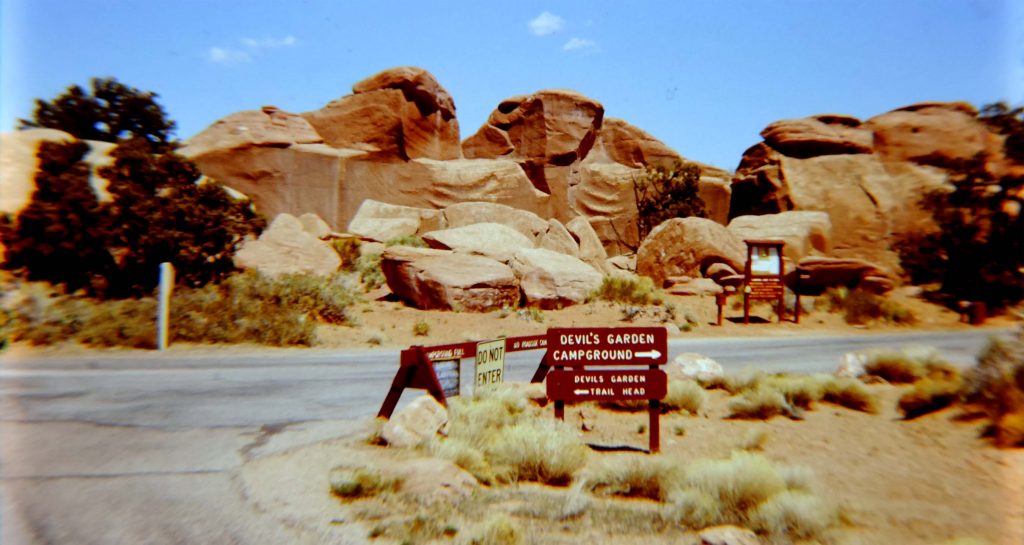
I was at my ranger residence, my Castle, my little rat-infested tin trailer, listening to Merle Haggard on Moab’s AM station, KUTA, when she showed up at the door. The girl was almost incoherent with fear. We drove back to the campsite and…yep…there he was. Still whimpering. I climbed out of the park jeep and assessed the situation. Carefully. Finally I said:
“Okay. So look…I could go back to our rescue cache and get the gear and come back, set up some anchors and do the whole Rescue Thing… But seriously, you could also just jump. It’s only ten feet. This juniper will break your fall.”
I shook a limb to show how sturdy it was. But the kid was now hysterical. His eyes were bulging (bad sign) and he screamed, “Oh my GOD, Ranger!” he cried. “PLEASE oh PLEASE save me! I can’t hold on much longer!”
Well for pity’s sake, I thought to myself, here we go again. (This was toward the end of my ranger career) His girlfriend’s lip was trembling and I wondered why such a lovely young woman was with this lunkhead to begin with. It even passed briefly through my albeit shallow 32 year old consciousness that if I did this well, and did it in a somewhat heroic manner, that she might realize she had other options besides this goofy rim-rocked alleged boyfriend, and might change allegiances, so to speak.
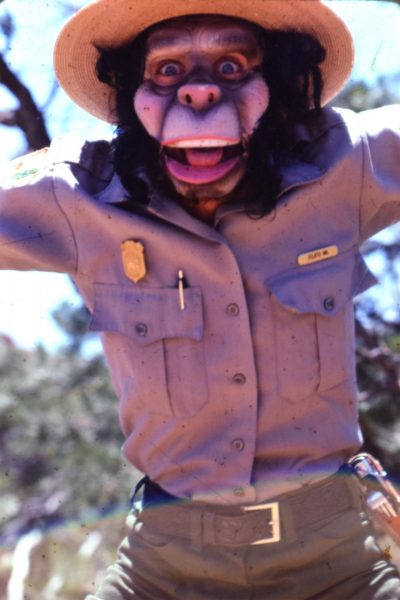
Stiles as “jerk/ranger” Gorilla.
So I broke out the gear, climbed to the top of the 20 foot Entrada sandstone fin and did the whole Ranger Jim Rescue Schtick, with the ropes and the harnesses and the carabiners. When we reached the ground, the young couple embraced and I waited for my own reward. Instead the girl actually growled at me and threatened to report my cold-hearted ass to my supervisor. She said I “lacked compassion.”
(“Asking him to jump! What kind of an insensitive jerk-ranger are you anyway?”)
“Jerk-ranger?” So…it was usually like that. But not always. Sometimes we had real emergencies and real crises that required our skills, our patience, our stamina, and our devotion to duty. At $5.63 an hour, we sure weren’t in it for the money. But each time the appearance of a threat to life or limb became known to us, we had to respond as if it were the ‘real thing.’ Only later could we laugh at, or complain about, or ridicule the would-be victims. After a few years, the stress of just waiting for something to happen took its toll on many of us. When I finally left the National Park Service, not once did I ever wish that I was back there, picking screaming teenagers off precarious cliffs.
So though we rangers often exhibited an unhealthy loathing for the masses of tourists that descended upon our park, we still took our jobs seriously when we needed to. It was always interesting to see how an honest-to-god emergency could transform us from wise-cracking cynics to dedicated lifesavers, in the blink of an eye.
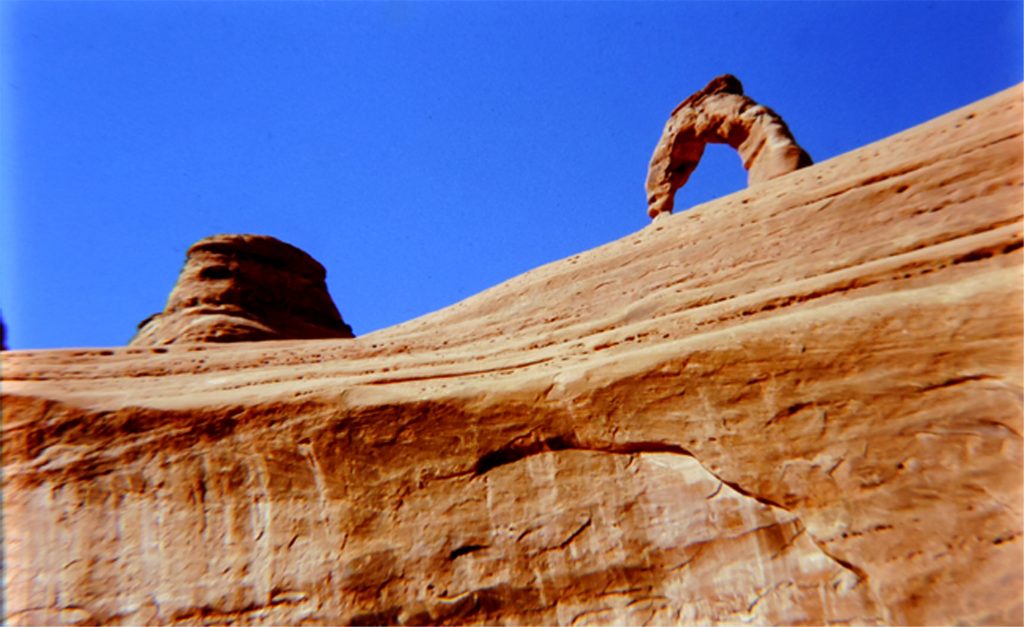
We were trained to deal with a plethora of emergencies, but they usually fell into three categories:
* Technical rescues as a consequence of a failed amateur rock climbing incident. Almost all of these events were the result of inexperience and lack of equipment. They thought they were more talented than the reality of their situation.
* Organized searches for lost and missing hikers.
* Other medical crises, not related to examples 1 and 2 (usually heart attacks, car accidents, burns from cook stoves, poison ivy, dog bites, even chlorine poisoning?)
For this “Ranger Stiles” installment, I’ll limit the narrative to those pesky and sometimes terrifying rescues.
TRAINING FOR DISASTER.
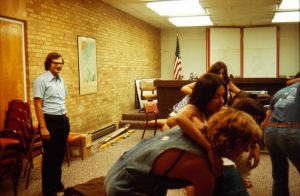
Jerry Epperson teaching Advanced First Aid and CPR
Though I was a ranger at Arches for over a decade, I always remember the first few years with more clarity and fondness. In 1976, the staff at Arches was small, and it felt like family to me. Our chief ranger, Jerry Epperson, was an incredibly talented, multi-skilled ranger who somehow took a personal interest in me and exhibited far more confidence in my potential than I did.
I was convinced Epperson could do anything. He was an expert rock climber but he was also skilled at technical rescues, in all degrees of complexity and complication. He was a brilliant four wheeler (“Don’t go fast…go slow…creep.”) and a genius with a Warn winch. He was a medical technician. He could track lost hikers across bare sandstone, and he could pound fence posts like an old cowboy, and yet he could also tell the difference between a long-billed curlew and a marbled godwit. Epperson contained multitudes.
He was also a good teacher and always eager to pass his skills along to his ranger staff; consequently, he made sure all of us were ready for any emergency that confronted us. Every spring, after we seasonals had returned to duty, Jerry led all of us to a high sandstone wall adjacent to the Park Avenue parking area. From there we hauled all our climbing and rescue gear up a steep 200 foot talus-filled crack to a narrow shelf of rock. On that ledge, each year, Epperson re-familiarized us with the equipment and basic climbing skills we’d need to at least assist in a technical rescue.
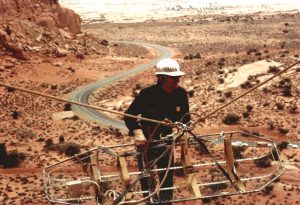
Rescue training with a Stokes litter. 1977
In those days, I had more nerve than brains (or skills) and I kept volunteering to try different maneuvers and techniques that were completely unknown to me. I still remember my first rappel. I was roped up, hooked into the brake bar, with a second belay rope secured with a bowline-on-a-coil. All I needed to do now was go.
Jerry explained the protocol for a rappel and the commands I needed to give. “Say, on belay,” he instructed. My belayer–the guy holding the backup rope— was ready. “OK,” Jerry said, “Say on rappel and go.” I hesitated. Epperson frowned. “Go! Go on…lean back. You have to lean back! And then just walk yourself down the cliff face.”
Sure, I thought…that’s easy for you to say. Leaning back over two hundred feet of nothing seemed…I don’t know…insane? But I did it anyway and I survived and eventually came to love that feeling when you know you’ve tied your knots properly and your equipment is solid and your belayer likes you.
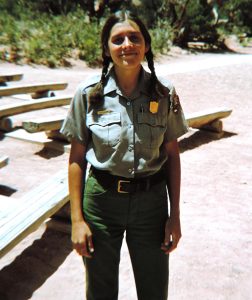
Park Naturalist Julie Walton
Because the staff at Arches was so small, Epperson made sure everyone was trained to participate in a technical rescue if the need arose. So the Arches naturalists, Kay Forsythe, Julie Walton, and Chris Pritchett got the same training that Roger Maki, Ron Lucas, and I received. We all knew we could depend on each other in a crisis. We were ready.
NEAR MISSES. CLOSE CALLS.
In the early days, I almost longed for some kind of rescue emergency to occur. I wasn’t hoping for drama, despair, and death, but I did want an opportunity to test my recently acquired skills, or I was likely to forget them. But most of the time, a full-fledged disaster remained just a scenario. More often it was the routine mini-rescue—what I liked to call “cute little rescues.”
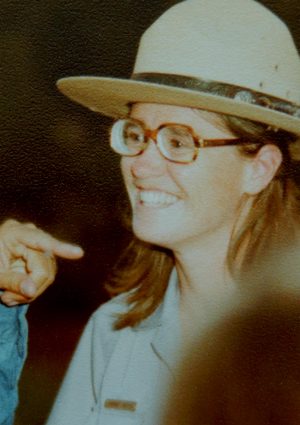
For example, one afternoon, we were notified that a 12 year old boy was missing near Balanced Rock. He had wandered away from a family picnic and didn’t return. After two hours, they called us. He’d last been seen heading toward the Petrified Dunes and so I wandered in that direction too. For about 15 minutes, I called his name as I looked for tracks. I’d yell, “Billie! Billie!” and wait for a reply.
Nothing. Nor did I expect one really. A few minutes passed. I stopped again and called his name. I thought I heard something.
“Billie?”
In a faint whisper, something mumbled…
“Billie?’
“whuut.”
“BILLIE??”
“Whuut?”
“Billie???”
Almost indignantly, “WHHUUT!?”
There was Billie. He’d slid into a six foot deep pot hole and he couldn’t get out. Young William was sitting there quietly, his head and arms draped over his propped up knees. He was unhurt but mortified. Billie may have preferred if I just left him there to die of thirst. But I said, “Do you want me to get you out of there?” He looked up, eyes welling with tears and nodded.
I ran back to the park cruiser, found a short piece of sling rope and returned to Billie’s hole. I pulled him out in 15 seconds.
Most of our rescues occurred near the campground. Keep in mind that, in the late 1970s and 1980s, technical rock climbing on sandstone was still rare. To make it even more difficult, the Arches staff reviewed its climbing policy and added some caveats that dramatically reduced climbing thrill seekers. We banned technical climbs on any named feature and on all arches. Further, at the park’s discretion, we could prohibit any technical climb within sight of the park road if we thought it might cause traffic issues.*
( * The policy was reversed in 1986 by a new acting chief ranger who loved rock climbing. Years later, that reversal led to the infamous and highly self-publicized “first ascent” of Delicate Arch by the late extreme athlete Dean Potter.)
Consequently, if the climbers couldn’t perform publicly, and if they couldn’t “bag and brag” a well-known park feature, their interest in climbing waned. There were plenty of anonymous walls and spires to scale in the backcountry, but where was the thrill in that? Nonetheless, we still found our share of over-confident exuberant young men who wanted to push the envelope and their luck.
The highest point at Arches is Elephant Butte, in the Windows section. One afternoon, a tourist reported that a young man was calling for help from a high precipice near the Parade of Elephants. Sure enough, I spotted a kid way up a vertical wall, at the mouth of a sandstone drop-off. How did he get there?
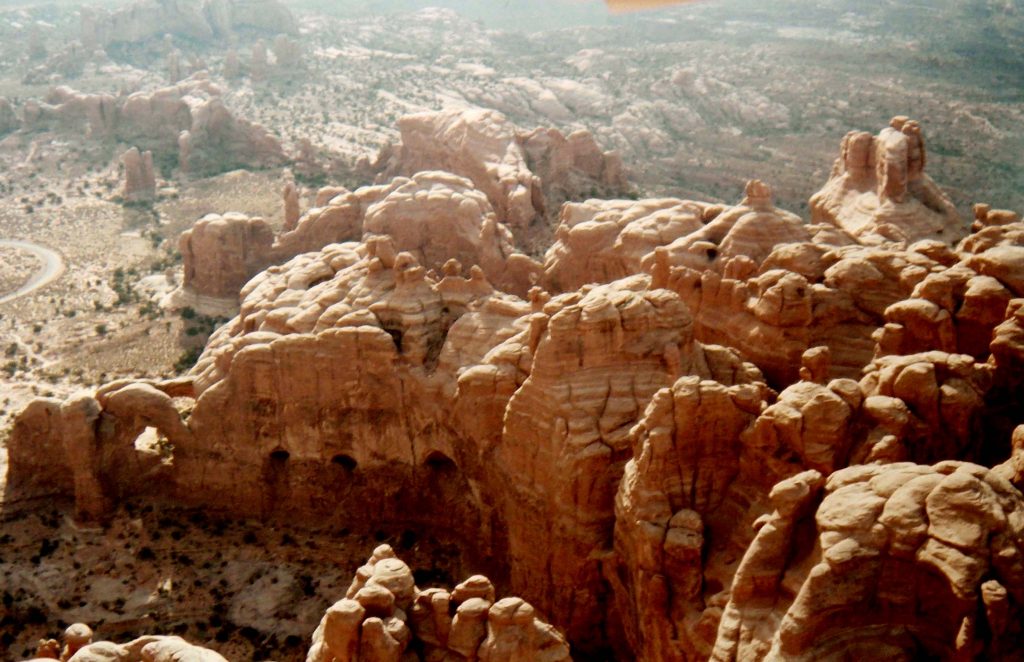
Aerial of Elephant Butte. 1978
All these years later, I don’t know if someone has removed it, but in 1981 the remnants of an old cable ladder were still barely clinging to the sheer rock wall below him. It had been built by some of the very early explorers of the Arches, perhaps the famous pioneer rock climber Fred Ayers. But all these years later, it was still anchored to a steel hammer that had been pounded into a drilled hole in the Entrada sandstone. It hadn’t been used in 50 years and most of the wooden rungs had long ago disintegrated.
But this boy somehow decided to climb the rickety, frayed, cable ladder, for no other reason than to see where it went. He made it to the top but then decided that he might need some help getting down. Coincidentally, I’d found a much easier route to the top earlier that year; we told him to stay put. That afternoon, fellow Ranger Mike Meyer and I retrieved the young man. We even posed for a group photo.
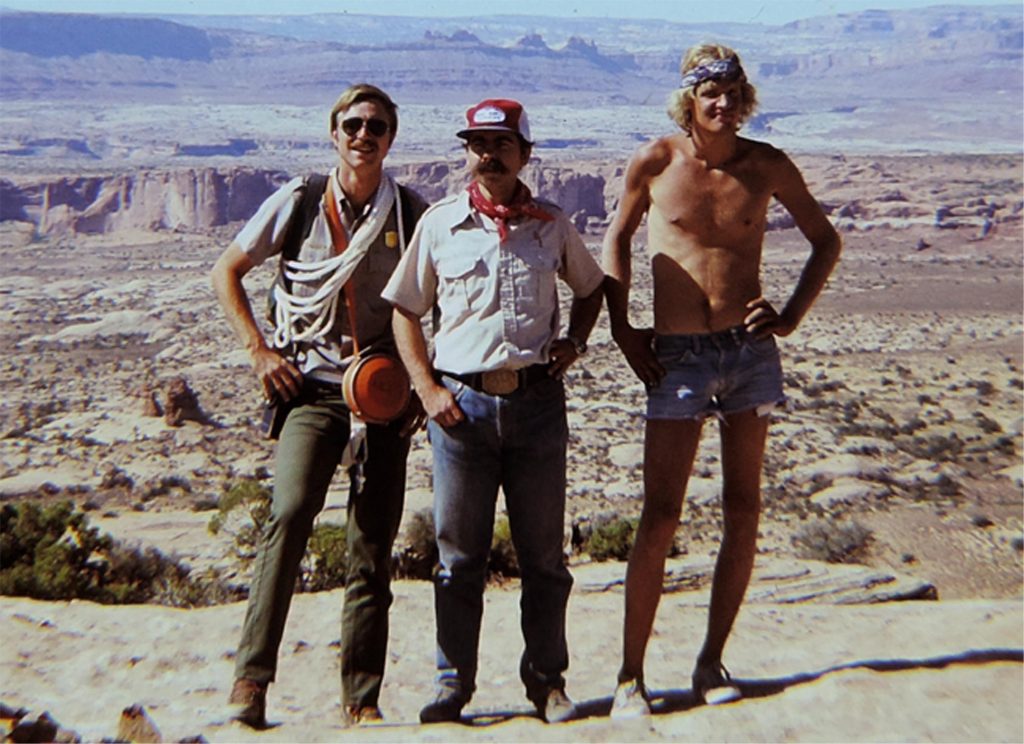
Rangers Mike Meyer, Wyatt Woodsmall & the stranded hiker.
There were other close calls.
Another male thrill seeker (age 23, of course) rim-rocked himself along a narrow shelf on a fin north of Landscape Arch. But unlike the rim-rocked idiot mentioned at the beginning of this story, he was a hundred and fifty feet above the canyon floor. He was screaming like a baby. Ranger Roger Maki and I responded, did the ranger rescue routine and pulled him up. The instant the kid was out of harm’s way, he pumped his fist and yelled, “What a fucking rush!”
I wanted to push him off the cliff face but Roger told me it would be wrong, especially after we’d already gone to the trouble of saving him. Finally, between clenched teeth, I said, “You almost died out there.”
He grinned and said, “I can’t help it, dude! Like…the rocks are in my blood!”
Roger grabbed him by the collar and said, “In a matter of moments, your blood was going to be on the rocks.”
The kid just smirked and said, “Hey Dude…I pay your salary. Like…you get paid to help people like me.”
“Not nearly enough,” Roger said.
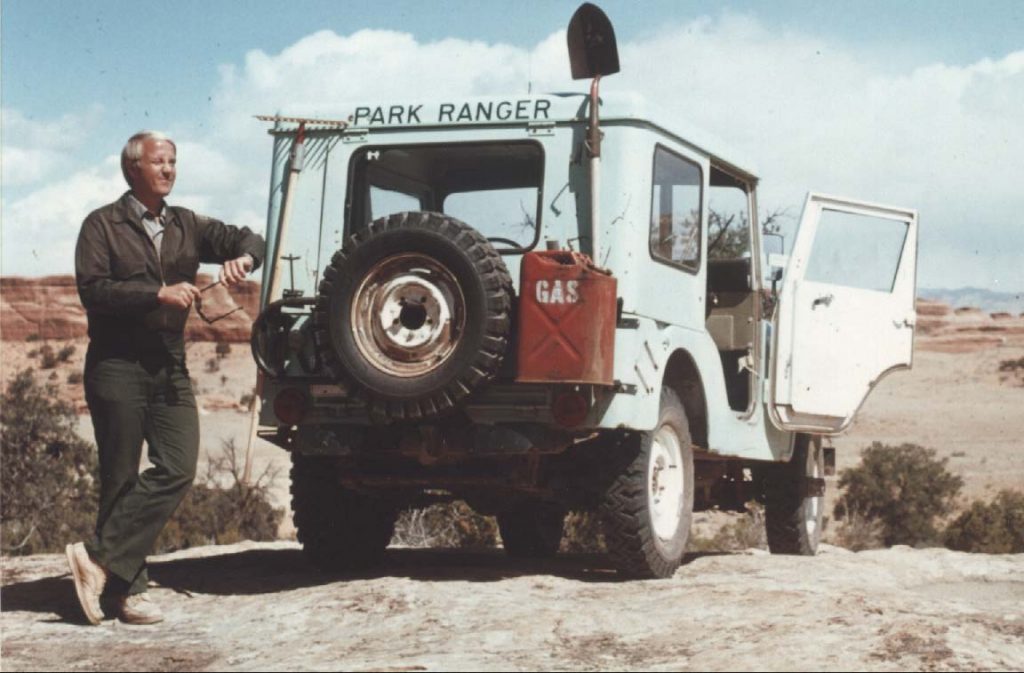
One of our own staff, a Student Conservation Aid (SCA) almost bought the farm one evening, trying to scale a 50 foot rock wall near the river. His belayer forgot to belay, (which is bad). When the SCA lost his footing, the belay rope should have been taut and kept him safe. Instead, he fell 30 feet and hit the ground hard.
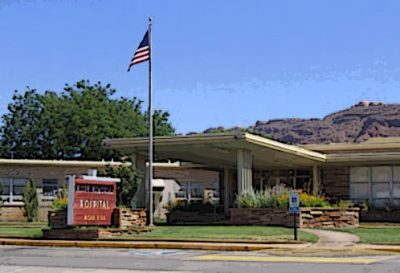
Allen Memorial Hospital in Moab
He seemed okay at first but within minutes his belly started to swell and he began to experience extreme abdominal pain. He was rushed to Allen Memorial Hospital where Dr. Mayberry assessed the situation and performed emergency surgery. Mayberry was a legend in Moab and beloved by everyone who ever met him. He knew exactly what had happened—the impact of the fall had caused the young man’s intestine to telescope on itself and completely pinched off the flow of food and gases. Our SCA was in danger of literally exploding like an over-inflated balloon.
With only minutes to spare, Dr. Mayberry called in every available staffer, even non-medical secretaries and administrators. He cut the boy open and then pulled all 25 feet of his intestine out and ran it around the room. Each of his volunteers was holding about three feet of gut. Then Mayberry inspected every inch, looking for the obstruction. Finally, he found the blockage, relieved the pressure, stuffed the kid’s guts back inside and sewed him up. The SCA recovered.
AS TOUGH AS IT GETS…
Anyone in the “emergency” business knows that all the training and education imaginable never really prepares them for the “real thing.” Our chief ranger, Jerry Epperson often threw worst case scenarios at us and our ability to respond successfully varied. On a scorching hot Sunday afternoon in July, the gods threw the book at us. At the time, it was probably the most complicated and dangerous rescue in the park’s history, and probably still is.
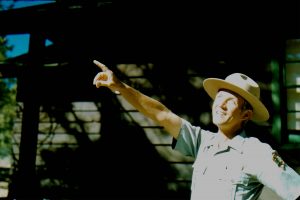
Roger Maki and I were the Devils Garden seasonal rangers and the only staff that actually lived in the park (HQ was along US 191, 18 miles away). We were in the middle of lunch, when a frantic knock on the door ended our noontime break. A breathless hiker told us that his friend had fallen near Landscape Arch and was seriously injured. It appeared, he said, that the friend had shattered his right arm.
“You mean below the arch somewhere?” I asked?
“No,” he replied.
“He was above Landscape and fell on to it.”
He told us that they’d traversed a sandstone ledge trying to reach the top of Landscape. But his friend, David Shapiro, had fallen 40 to 50 feet and was in trouble. On the way down he’d struck his head on the rock and had apparently been unconscious for a while.
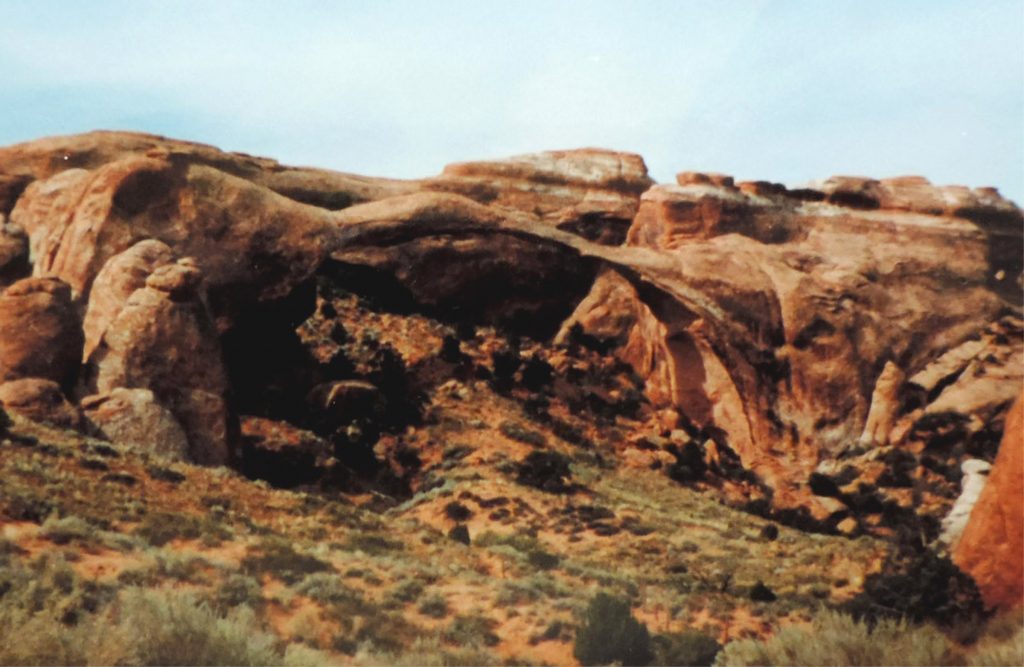
Landscape Arch.
We practically sprinted the mile to where we could see the arch. I asked the victim’s friend to point out his precise location. I couldn’t believe it. I could barely make out a figure slumped over at the base of a 50 foot cliff, adjacent to the arch, and 200 feet above the canyon floor. Just getting to the injured climber’s location would be a challenge.
Landscape Arch was formed on the far south end of a long narrow sandstone fin. The north buttress of the arch rises 50 feet above the span. The fin then continues north for almost a quarter mile. The only way to reach the far north end of the fin was to follow the trail up the long talus slope beyond Landscape and Wall Arches, to where the trail crested, then double back along the fin, over the top of Partition Arch.
The fin that would allow us to reach the victim was broken and eroded into sections. We could follow the rim until we came to one of those breaks, then we had to climb down and up the other side of the cracks and crevices. It took us almost an hour just to reach the spot where the man fell.
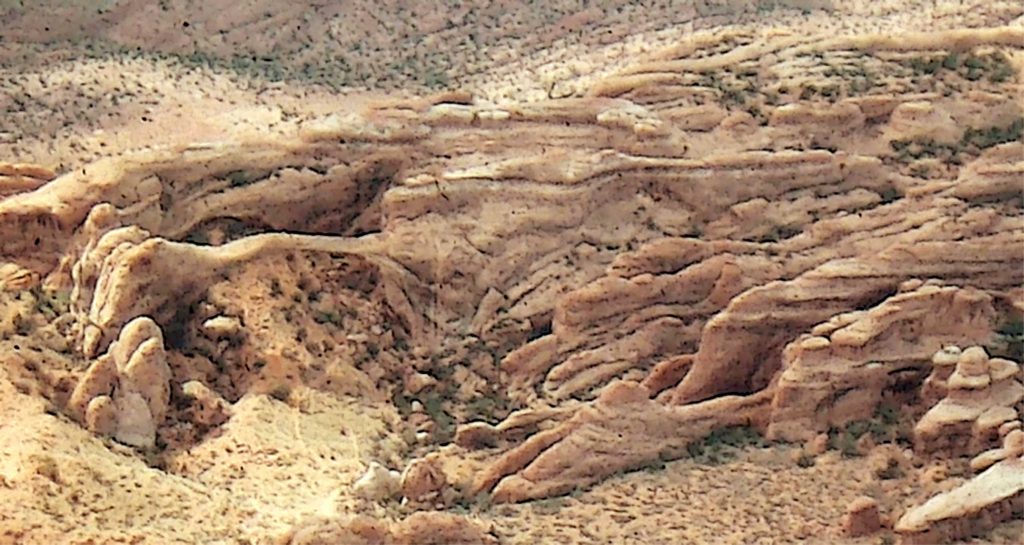
Landscape Arch aerial 1978.
But we couldn’t reach him. Incredibly, Shapiro had thought he could just ‘slide down’ the 50 plus foot vertical wall. From there he’d be able to access and cross Landscape Arch itself. But he never made it. One can only imagine what he must have thought when he eased over the side and suddenly found himself in free-fall. He hit a narrow shelf of rock 75 feet from the edge of the span. His arm was badly broken and he was in shock. He’d failed to bring water.
So…we were on the top of the fin; David Shapiro was stranded and injured, 50 feet below us. We needed to get our gear and start the process of extricating him from this nearly impossible situation. Roger dropped a canteen to him, we introduced ourselves and told Shapiro we needed more equipment and rangers to get him out of harm’s way. We had no idea how severe his injuries were or if there was internal damage from the fall. He was conscious, he could talk, but he was weak and disoriented.
A TRAGIC FLASHBACK…
At this precise location, 27 years earlier, Arches had experienced its first fatality when another hiker tried to perform precisely the same acrobatic stunt as Shapiro. His name was Fred Semisch.
Semisch was born in America to parents of German descent. But in 1939, he and his family traveled to their homeland to visit relatives, and were subsequently detained by the Nazi government… Semisch was reportedly an (albeit reluctant) young member of a Nazi youth organization.
After the war he was allowed to come “home” to the U.S., but his parents were detained for several years. In 1950, at age 19, Semisch took off from New York City for parts unknown with a buddy, Gilman Ordway. On Monday morning, May 29, 1950, Semisch and Ordway took a detour to visit Arches National Monument. The roads were rough and the area was very quiet (compared to today,) but there were other tourists along the trail and near Landscape Arch. After all, it was memorial Day.
Like Shapiro, Fred followed the top of the sandstone fin above Partition Arch and found himself staring down at the very top of the world’s longest stone arch. And like Shapiro, at almost precisely the same location, Semisch thought he could slide down a crack. Even short distances are hard to calculate in slickrock country. But apparently, when Semisch hit the narrow shelf of rock adjacent to the span, his momentum was too great to stop. He pitched forward and over the edge. The fall was almost 200 feet. A nearby amateur photographer and Fred’s friend heard him scream and saw his body plummet into a ravine at the wall’s base. He was dead on impact.
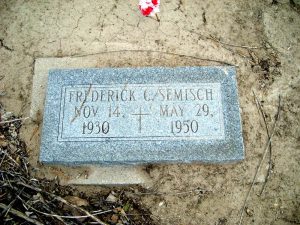
Superintendent Bates Wilson was notified and later hauled the young man’s body back to the trailhead on a mule. His family was still in Germany. Some relatives in New York refused to claim his body, and so days later, Frederick Semisch was buried in an unmarked grave in the Carbonville, Utah Cemetery. A decade later, his parents bought a headstone for their son.
BACK TO 1977…
Fortunately Mr. Shapiro did not go over the cliff. He was still alive and we needed to get him to safety as quickly as possible. First we had to decide on a plan. It was obvious that we couldn’t raise him up the fin and then carry him back across the half mile expanse of broken sandstone. We considered a helicopter rescue but there simply wasn’t enough room on this narrow sandstone shelf for it to land or even get close.
Our only option was to retrieve all our climbing gear, including the Stokes litter from the rescue cache at the trailer, then haul it back over the Devils Garden Trail to the top of the long slope beyond Landscape, then over the fin to the location above him. We’d need to perform a first rappel from the fin to the shelf below where Shapiro was trapped, then rig the litter (a steel wire mesh stretcher), strap the injured Shapiro inside it, and finally lower Shapiro and a ranger (me) down the cliff, almost 200 feet to the ground.
From there, we’d carry him a mile on foot to the Devils Garden trailhead where an ambulance would be waiting.
But we needed help. Badly. And it was Sunday. Our boss, Jerry Epperson was the most highly skilled technical rock rescue team leader in southeast Utah, and I felt better knowing that Jerry would be in charge, until I remembered that he and his family had left for the weekend and wouldn’t be home until late that night. We needed more rangers.
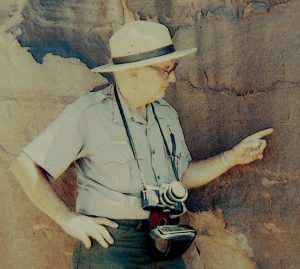
Our communications were hampered by our ineffective Motorola two-way radios (no cell phones back then,) and we were busy enough just trying to assemble our gear and move it back along the trail. Arches naturalists Jim Capps and Ed McCarrick heard our calls and helped us haul the gear. But we also needed a ranger with climbing experience.
Tom Wylie, the chief ranger at Canyonlands National Park, heard our radio transmissions and offered to help. Within 30 minutes, Tom was with us hauling two 300 foot Perlon ropes, the Stokes litter, slings and harnesses, webbing and carabiners, pitons, impact drills–we hauled hundreds of pounds of gear to the site—plus first aid supplies for Shapiro.
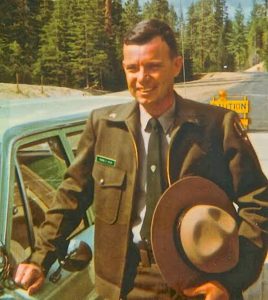
Finally, we had the equipment where we needed it, and then lowered ourselves down the first 50 foot rappel to Shapiro. It was the first time we’d been close enough to look at his injuries. His arm was badly broken but he was alive.
For the next hour we prepared for the descent. We were lucky to find natural anchor points for both the belay and rappel ropes, but the Perlon ropes turned out to be a disaster. They were brand new, right out of the box, but when we tried to uncoil them, they were so twisted and tangled, it took us 30 minutes just to get the lines straight.
We rigged the litter, and attached my line to it. I was chosen to go with the litter, partly because I was the lightest ranger there, and because I stupidly kept volunteering (later, I got over that). But the plan was, I would walk the Stokes litter and Shapiro down the cliff-, holding onto the side of the litter, and attempt to keep Shapiro as calm and comfortable as anyone can feel being lowered off a 200 foot cliff.
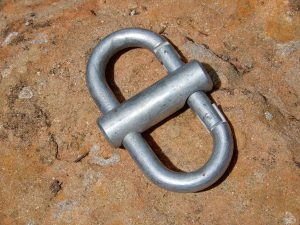
Then Tom said, “Where are the brake bars?” A brake bar is…well…it’s a bar that fits across the carabiner (see photo). The rope threads through the carabiner, over the bar and back out again. Its purpose is to create friction and slow the descent of whatever it is that’s descending—in this case, David Shapiro, a 50 pound steel basket, and me.
Shapiro was in the crate and ready to go and in great pain. Now we were all trying to find this little aluminum bar that could make all the difference in whether we made it to the bottom of the cliff in a timely manner, or in… like four seconds. I was worried.
But Tom said, “It’s okay…I can rig something up here and it’ll be fine. Let’s go.” My trust and confidence in Wylie was so great that I never thought about the brake bar again. I knew if Tom said we’d be okay, we’d be okay. We dragged the litter to the edge of the cliff and made the transition–we were going down.
All was well, at first. I was walking the Stokes down the wall, just like one of Epperson’s training sessions. Easy. Then we stopped. We were too far down to hear anyone above us and no one below (we’d created a crowd of sorts). Then suddenly, the line slipped and we sort of free-fell for about twenty feet. Then the line went tight again.
Shapiro, who had almost fallen asleep, was brought back to life by the jolt. We both experienced new levels of intense awareness. He looked at me, bug-eyed and said, “That was interesting.”
I just nodded. Then we slipped again, another 30 feet. Then ‘boing.’ We stopped. We descended like that, in fits and bursts, instead of the steady lowering I’d expected. Later I learned it was the damn Perlon rope again. As it fed through Tom’s improvised brake bar, the nylon rope kinked and twisted until it would no longer thread the bar. Roger would then un-kink the rope while Tom kept tension on the rope. Wylie’s makeshift brake bar was almost as good as the real thing, but it almost meant we had a slightly more interesting ride down.
(A day later, I found the brake bars in a compartment of the pack that we’d overlooked during the frenzied time when we were rigging the litter.)
Finally, I could see bottom. My feet touched the ground, we lowered the litter a bit more and—contact light—we were down. Never had sand felt so good under my feet. I was so focused on the rescue and on the rigging that I’d failed to notice the crowd of tourists that had gathered to watch. When we touched down, a smattering of applause broke out. There were other rangers there to assist in the last mile of the carry-out and some of the tourists assisted as well. I was so wobbly I could have used a lift myself, but we made it to the Devils Garden parking lot.
And for the life of me, I can’t recall a single detail of the remainder of that day, once we got the man to the parking lot. It’s a complete blank. Later, Roger and I met up at the trailer. He and Tom had hauled all the equipment back over the treacherous sandstone fin and to the campground. We were collectively exhausted beyond our ability to describe it. Later we learned that our injured hiker was doing well and had gone home to Chicago, where the cliffs aren’t so high.
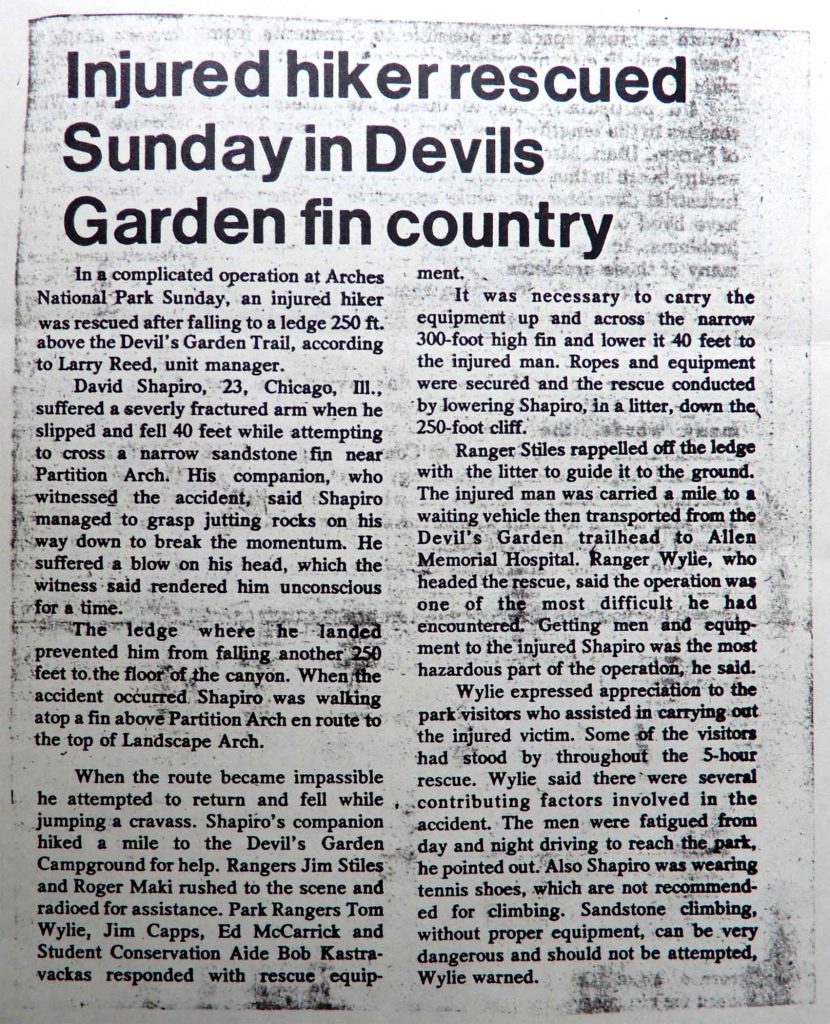
The Times-Independent. July 1977
A few weeks later, another hiker fell and injured himself and again, Roger and I made our way along the crest of the same fin, but this time the hiker had at least stayed on top, so extricating him was a bit easier. Then another guy got rim-rocked. Finally we put up a sign that pleaded:
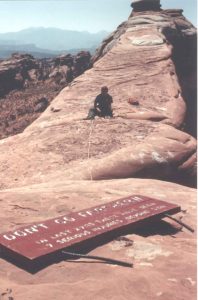
DON’T GO FARTHER!!
In last two years, there have been seven serious injuries.
But they went anyway. Then somebody pulled out the sign. We put it back, somebody pulled it out again. Decades later, I have no idea if the sign is still there. I doubt it.
* * *
My enthusiasm for technical rescues, and those individuals needing rescuing, waned over the years. There wasn’t a single incident I can recall where the crisis wasn’t self-inflicted. These foolish people were not only willing to put themselves at risk, but also those of us who tried to save them. I grew more cynical with each “incident.”
By the end of my Park Service career, I was probably not fit to be part of the technical rescue team. I was indeed —at least half-seriously— urging stranded hikers to “just jump,” though only from distances less than ten feet! Had I stayed on for another year or two, I might have raised the elevation requirement by a considerable distance…100 feet? 200?
But of course, none of these kids deserved to die or endure permanent disabilities and that was just me, venting in the moment. Looking back, I know I had my own reckless episodes, though I never caught the extreme sports fever. In 2019, injuries and death from extreme sports, and reckless or amateurish canyoneering/climbing skills have made these kinds of incidents almost routine, in Moab and Beyond. Hopefully these stories from my past help explain my lack of enthusiasm and even disdain for the extreme sports industry.
After I left the Park Service and had started The Zephyr, I was blessed to briefly know a beautiful young woman in Moab with an amazing heart. Unfortunately, she was drawn to extreme sports like a moth to a flame. We used to argue about her risk-taking and the danger she kept putting herself in. Finally, our differences led to a falling out between us. I honestly felt this sense of doom about her.
One day I bumped into her at the Broiler and we had lunch together. We were having such a nice time, I decided to avoid the subject of her constant dance with Death. But then she brought it up. “You haven’t given me crap about my recreational lifestyle for an entire 45 minutes!”
I just shrugged and smiled. I looked up at her and she was staring into space. “You know,” she said, “I keep pushing it, and I love it, but the other day…” She paused, “…the other day, I even scared myself.”
A month later, she and three others were caught in an avalanche in the La Sal Mountains. They’d gone too far. Her body was recovered the next day.
Click Here to read the previous installments of Ranger Stiles’ Wildlife Observation Notes…
Jim Stiles is Founder and Co-Publisher of the Canyon Country Zephyr.
To comment, scroll to the bottom of the page.
Don’t forget the Zephyr ads! All links are hot!






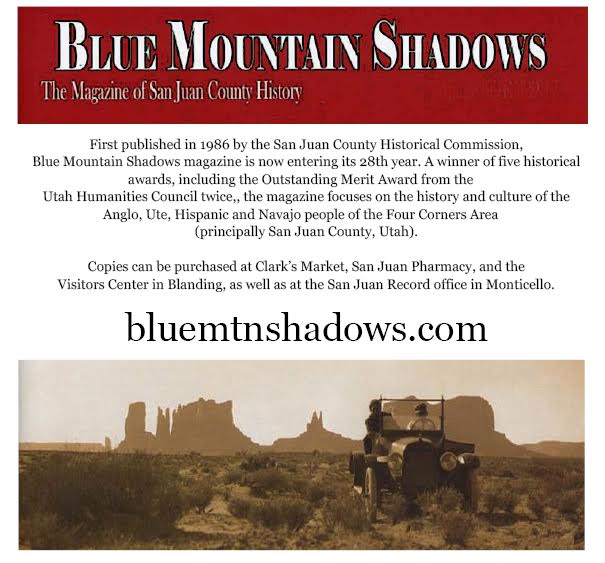



Did you ever find Roger Maki? What happened to Jerry Eperson?
I’m so happy to run across the official version of the “WHUT” story, which I first heard from Stiles in the 80s while camping in a teepee at the Devils Garden Campground. Although I’ve always remembered it as Roger or Kevin and not Billy, and the pothole being somewhere near the campground. The specially-inflected “WHUT” has become part of our family lexicon.
p.s. There is, or was, an old-timer in Jackson Hole by the name of Gilman Ordway. I wonder if it’s the same person or a relative.
Great article. Thank God for young , capable, dedicated rangers like you were. Fascinating story.
an exhausting, tho’ thorough (well, as far as i kin tell) read. in particular, the lady who thought you lacked compassion, or the analorifice who “pays your salary.” sheesh — no wonder they get into these pickles ~
Death defying is what you were! Your 10 years as a Ranger were certainly educational but quite precarious! Every young hiker should read this, knowing what danger, not only they encounter, but how their thoughtless acts endanger their rescuers! Kudos to you for those years of dedication but also to all Rangers, past and present.